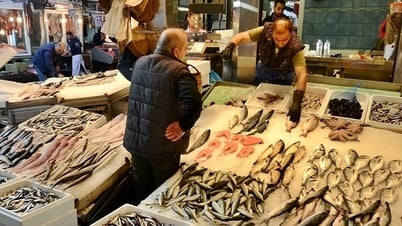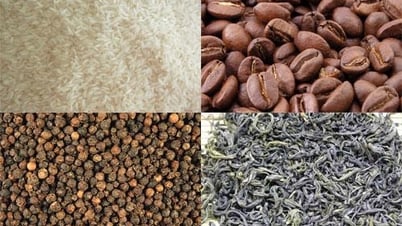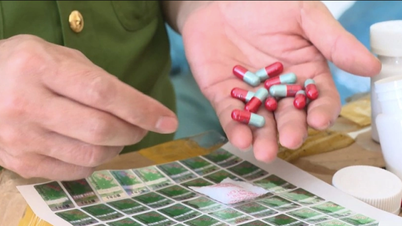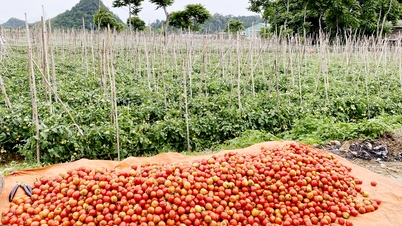
Proactively restore herds to supply Tet market
African swine fever is becoming more and more complicated, with outbreaks appearing in many localities, while the consumption market is slow and pork prices are low, causing many farms and households to face many difficulties. Mr. Nguyen Van Cong - owner of a farm in Hien Son commune (Do Luong) said: "This year, pig farmers are facing many difficulties due to fluctuating prices and complicated epidemics. Therefore, we are looking forward to a prosperous market at the end of the year, when demand increases, purchasing power increases and prices increase."
Therefore, in addition to maintaining 30 pigs in the barn, from the beginning of the 10th lunar month, Mr. Cong bought 20 more pigs to fatten and sell during Tet. “Due to African swine fever, when buying pigs to increase the herd, I pay special attention to the origin of the pigs, quarantine papers and quarantine before adding them to the herd. After 2 months, I will separate industrial bran, increase roughage and green food to increase muscle, reduce fat, and have good meat quality to sell during Tet,” Mr. Cong added.

Raising pigs on a large scale, maintaining continuous production throughout the year, but at the end of the year, the farm of Kim Tien Dai Phat Cooperative in Hoa Hieu ward (Thai Hoa town) increased the herd of wild pigs and Mong Cai hybrid wild pigs due to high demand from traders.
Ms. Nguyen Thi Kim Tien - representative of the cooperative said that since the end of September, when selling the litter of 100 wild boars, she has separated 200 purebred wild boars and 100 crossbred wild boars, bringing the total wild boar herd to 500 to supply the Tet market.
Due to the closed system from input to output, the disease problem is not a concern. Up to now, the cooperative has received orders for wild boar from traders and slaughterhouses. At the same time, the herd of pigs for meat is increasing to serve the processing of ham, sausage, floss, spring rolls, etc. at the end of the year.

With many years of experience in raising chickens, for the end of the year batch, Mr. Nguyen Manh Cuong in Thanh Lien commune (Thanh Chuong) often increases the flock by 200-300 birds due to the high demand of traders. Accordingly, he mainly increases the flock of sugarcane roosters. With characteristics such as short body, big thighs, deep eyes, red comb, shiny feathers and golden legs, they are very popular for making chickens for feasts and offerings.
“After selling the second batch of chickens of the year, the farm was reinforced, disinfected, and sterilized, and the flock was increased to 1,000 chickens, an increase of 300 chickens compared to the previous batch. The majority of them are sugarcane roosters because during the Tet holiday, the demand for chickens for offerings increases; in addition to serving the Kitchen God worship and the 3-day Tet worship, they are also used for the Khai Ha and the Full Moon Festivals of January. Every year, this batch of chickens is always in high demand and has a good price,” said Mr. Cuong.
Notes when entering the piano
In order to avoid creating pressure on consumption, in addition to the structure of different breeds to serve different needs, farms and households also spread out the release batches, 20-35 days apart. If the Tet holiday does not sell out, the selling time can be extended to January or February.
With a scale of 1,000 chickens, Mr. Dang Phuc Hai in Thuan Son commune (Do Luong) is focusing on taking care of the chickens serving Tet food and the structure of the Tet chicken flock with many different breeds. "The sugarcane roosters are sold as offerings; the grass hens are used to make salt and pepper chickens for establishments and agents; the young hens are used to make various types of chicken meatballs and chicken ham; the crossbred fighting chickens are used to make dried chicken... The chickens at the end of the year are usually easy to sell, and the selling price is also higher than other times of the year," said Mr. Hung.

In addition, herd restoration to serve the year-end market in the transitional season often occurs with severe cold spells that affect the growth and development of livestock, so the Department of Agriculture directs localities to focus on implementing disease prevention and control measures and vaccinating according to regulations.
In addition, forecasting market demand is carried out to have a plan to guide people in repopulating their herds, orienting the number of animals raised, and avoiding massive repopulating; encouraging breeders to take advantage of available agricultural products and by-products to reduce costs, as well as not using poor quality feed, not using banned substances in breeding, and ensuring the quality of livestock products when sold.
According to statistics, the province currently has a total poultry herd of about 35 million; a pig herd of about 1 million and a buffalo and cow herd of about 801,000. At the end of the year and during the Lunar New Year, the demand for livestock products can increase by 10 to 30% compared to normal days. Currently, the supply of livestock, poultry and eggs is quite abundant, meeting the market demand at the end of the year.
Source



![[Photo] Prime Minister Pham Minh Chinh meets with Hungarian President Sulyok Tamas](https://vphoto.vietnam.vn/thumb/1200x675/vietnam/resource/IMAGE/2025/5/29/dbcaa73e92ea4448a03fe1d0de6d68e8)


![[Photo] Vietnamese and Hungarian leaders attend the opening of the exhibition by photographer Bozoky Dezso](https://vphoto.vietnam.vn/thumb/1200x675/vietnam/resource/IMAGE/2025/5/29/94d8ceca5db14af3bf31285551ae4bb3)
![[Photo] Prime Minister Pham Minh Chinh receives a bipartisan delegation of US House of Representatives](https://vphoto.vietnam.vn/thumb/1200x675/vietnam/resource/IMAGE/2025/5/28/468e61546b664d3f98dc75f6a3c2c880)



















































































Comment (0)